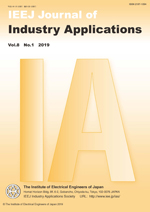Volume 8, Issue 4
Displaying 1-22 of 22 articles from this issue
- |<
- <
- 1
- >
- >|
Special Issue on “JIASC 2018”
Special Issue Paper
-
2019 Volume 8 Issue 4 Pages 576-585
Published: July 01, 2019
Released on J-STAGE: July 01, 2019
Download PDF (1966K) -
2019 Volume 8 Issue 4 Pages 586-591
Published: July 01, 2019
Released on J-STAGE: July 01, 2019
Download PDF (1677K)
Special Issue on “IPEC-Niigata 2018”
Special Issue Paper
-
2019 Volume 8 Issue 4 Pages 592-599
Published: July 01, 2019
Released on J-STAGE: July 01, 2019
Download PDF (2700K) -
2019 Volume 8 Issue 4 Pages 600-607
Published: July 01, 2019
Released on J-STAGE: July 01, 2019
Download PDF (1992K) -
2019 Volume 8 Issue 4 Pages 608-614
Published: July 01, 2019
Released on J-STAGE: July 01, 2019
Download PDF (1678K) -
2019 Volume 8 Issue 4 Pages 615-622
Published: July 01, 2019
Released on J-STAGE: July 01, 2019
Download PDF (3214K) -
2019 Volume 8 Issue 4 Pages 623-631
Published: July 01, 2019
Released on J-STAGE: July 01, 2019
Download PDF (1585K) -
2019 Volume 8 Issue 4 Pages 632-637
Published: July 01, 2019
Released on J-STAGE: July 01, 2019
Download PDF (4401K) -
2019 Volume 8 Issue 4 Pages 638-643
Published: July 01, 2019
Released on J-STAGE: July 01, 2019
Download PDF (4364K) -
2019 Volume 8 Issue 4 Pages 644-651
Published: July 01, 2019
Released on J-STAGE: July 01, 2019
Download PDF (4558K) -
2019 Volume 8 Issue 4 Pages 652-659
Published: July 01, 2019
Released on J-STAGE: July 01, 2019
Download PDF (2029K) -
2019 Volume 8 Issue 4 Pages 660-668
Published: July 01, 2019
Released on J-STAGE: July 01, 2019
Download PDF (2655K) -
2019 Volume 8 Issue 4 Pages 669-676
Published: July 01, 2019
Released on J-STAGE: July 01, 2019
Download PDF (2583K) -
2019 Volume 8 Issue 4 Pages 677-684
Published: July 01, 2019
Released on J-STAGE: July 01, 2019
Download PDF (1824K) -
2019 Volume 8 Issue 4 Pages 685-693
Published: July 01, 2019
Released on J-STAGE: July 01, 2019
Download PDF (4224K)
Paper
-
2019 Volume 8 Issue 4 Pages 694-703
Published: July 01, 2019
Released on J-STAGE: July 01, 2019
Download PDF (4888K) -
2019 Volume 8 Issue 4 Pages 704-712
Published: July 01, 2019
Released on J-STAGE: July 01, 2019
Download PDF (5279K) -
2019 Volume 8 Issue 4 Pages 713-719
Published: July 01, 2019
Released on J-STAGE: July 01, 2019
Download PDF (2073K) -
2019 Volume 8 Issue 4 Pages 720-726
Published: July 01, 2019
Released on J-STAGE: July 01, 2019
Download PDF (4642K) -
2019 Volume 8 Issue 4 Pages 727-735
Published: July 01, 2019
Released on J-STAGE: July 01, 2019
Download PDF (1665K)
Selected and English Translation Paper of IEEJ Trans. IA
-
2019 Volume 8 Issue 4 Pages 736-744
Published: July 01, 2019
Released on J-STAGE: July 01, 2019
Download PDF (1645K)
-
2019 Volume 8 Issue 4 Pages L4_1
Published: July 01, 2019
Released on J-STAGE: July 01, 2019
Download PDF (547K)
- |<
- <
- 1
- >
- >|
